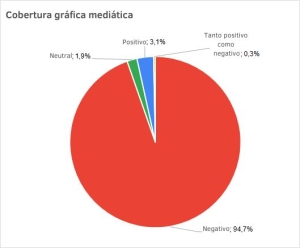El pasado martes 2 de mayo el Poder Ejecutivo Nacional ingresó a la Cámara de Diputados un proyecto de ley para la ratificación del Convenio Marco para el Control del Tabaco. Argentina es el único país de América del Sur que aún no lo ha hecho y su ratificación constituye una deuda pendiente para la salud pública. En esta nota te contamos por qué el Estado argentino no debe dejar pasar esta oportunidad y por qué es importante dar este paso para la adecuada protección del derecho a la salud.
El Ministerio de Salud de la Nación, en la última Encuesta Mundial sobre Tabaco en Jóvenes, reveló que nuestro país tiene una de las tasas de prevalencia en la adicción al tabaco más altas de la región. Los datos muestran que el consumo de tabaco produce 44.851 muertes anuales, representando el 13% de las defunciones totales y que todavía, más del 22% de la población consume tabaco, siendo cada vez menor la edad de iniciación en el consumo, que ya se sitúa entre los 12 y 15 años.
Asimismo, de acuerdo a un estudio publicado por el Instituto de Efectividad y Clínica Sanitaria, nuestro país gasta cada año aproximadamente 197.000 millones de pesos en atender las enfermedades que provoca el tabaquismo (como ser enfermedad pulmonar obstructiva crónica, enfermedades cardíacas, cáncer de pulmón, entre otras), representando el 7,6% del gasto sanitario local. Además, como si ello fuera poco, el tabaquismo golpea principalmente a los grupos sociales en situación de vulnerabilidad por lo que genera un círculo vicioso de pobreza y enfermedad, y ha sido internacionalmente reconocido como una barrera para el desarrollo sustentable.
Es este contexto el que determina la urgencia de avanzar con la ratificación del Convenio Marco para el Control del Tabaco (CMCT). Se trata del primer tratado internacional de salud pública celebrado en la Organización Mundial de la Salud (OMS), que a la fecha cuenta con la ratificación de 182 países (incluidos todos los Estados que forman parte del Mercosur, excepto Argentina) y es uno de los pactos de mayor aceptación en la historia de las Naciones Unidas.
Es importante resaltar que este tratado fue elaborado para poder dar respuesta a la epidemia global del tabaquismo. Con este fin, el CMCT proporciona un marco integral para la implementación de políticas efectivas de control de tabaco dirigidas a reducir la oferta, la demanda y los daños causados por estos productos. Así, al ratificar este Convenio, Argentina se comprometería a adoptar una batería de medidas que permitiría robustecer el estándar de protección de salud pública.
Puntos claves de la ratificación
Actualmente, nuestro país cuenta con diversas disposiciones normativas en materia de control de tabaco e incluso, algunas de ellas adoptan las medidas que prevé el propio CMCT. Sin embargo, es importante resaltar que la incorporación de este instrumento internacional al sistema jurídico nacional continúa siendo esencial. Pues, hay regulaciones que aún son sumamente permisivas a los intereses comerciales de la industria, a la vez que existen ciertas problemáticas globales que necesariamente requieren de la cooperación internacional para su abordaje.
En este sentido, la adopción del Convenio Marco permitiría mejorar la prohibición amplia de publicidad, promoción y patrocinio de productos de tabaco incluyendo aquella con efectos transfronterizos. Esta medida adquiere una importancia fundamental frente a la globalización de las comunicaciones y a las inversiones millonarias en marketing que hace la industria. Mientras que la Ley Nacional de Control de Tabaco permite la presencia de mercadotecnia al interior de los puntos de venta, las comunicaciones directas a personas mayores de 18 años, así como las acciones de responsabilidad social empresaria por parte de las tabacaleras.
Asimismo, la ratificación del Convenio Marco le permitiría a la Argentina contar con mejores herramientas para afrontar la problemática del comercio ilícito, tal como lo es el Protocolo para eliminación del comercio ilícito de productos de tabaco, también celebrado bajo los auspicios de la OMS. De acuerdo a las investigaciones, el comercio ilícito -que implica el contrabando, la falsificación, la fabricación ilícita, entre otras formas- aumenta la accesibilidad y asequibilidad de los productos de tabaco, y transgrede las medidas relacionadas con los precios y las medidas fiscales dirigidas a disminuir la epidemia del tabaquismo. Este tratado reconoce que la eliminación de todas las formas de comercio ilícito es un componente esencial del control del tabaco y que requiere de la elaboración y aplicación de medidas tanto nacionales como internacionales. Dentro del ámbito del Mercosur, Argentina es el único país que no participa de las negociaciones para el control del contrabando, quedando fuera de las decisiones dirigidas a prevenir el comercio ilícito entre países vecinos.
A su vez, el Convenio Marco, a través de su artículo 5.3 y las directrices para su aplicación, confieren un conjunto de medidas orientadas a proteger las políticas de salud pública contra los intereses comerciales y otros intereses creados por parte de las tabacaleras, así como de los individuos u organizaciones que trabajan para promover los intereses de esta industria. En este sentido, se destacan la necesidad de establecer medidas para limitar las interacciones con la industria tabacalera a los supuestos en que sea estrictamente necesario para establecer una regulación eficaz de la misma y de sus productos; garantizar la transparencia de las interacciones que tengan lugar ya sea a través de audiencias y actas públicas; exigir que la información proporcionada por la industria sea precisa y transparente; establecer normas claras sobre conflictos de intereses para todas las personas que trabajen en el Estado y en la esfera de control de tabaco; desnormalizar y no aprobar, apoyar, asociarse o participar en las actividades que la industria tabacalera promueve como “socialmente responsables” (como ser iniciativas de educación pública, de asistencia sanitaria, etc.), entre otras recomendaciones. De este modo, el CMCT proporciona un marco legal adecuado para frenar la interferencia de la industria tabacalera en los asuntos de salud pública vinculados al control del tabaco.
Por último, es importante destacar que la ratificación del Convenio Marco, también habilitaría a que el Estado argentino pueda participar de espacios donde se toman decisiones relevantes para el control del tabaco y la construcción de estrategias de cooperación internacional. Ejemplo de esto es la Conferencia de las Partes, órgano rector del CMCT que se encarga de examinar regularmente su aplicación y de adoptar las decisiones necesarias para promover su eficaz implementación. Además, es un órgano desde el cual se promueven mecanismos para la transferencia de conocimientos técnicos, científicos, tecnológicos y jurídicos especializados, teniendo en cuenta las necesidades de los Estados Partes, si son países en desarrollo, si tienen economías en transición, etc.
Una cuestión de derechos humanos
Desde el preámbulo, el Convenio deja bien explicitado que se trata de un instrumento internacional “basado en pruebas científicas que reafirma el derecho de todas las personas a gozar del grado máximo de salud que se pueda lograr”. De este modo, expone la relación existente entre la tutela del derecho a la salud y las políticas de control del tabaco.
A este respecto, es importante destacar que la ratificación del Convenio Marco va en línea con las obligaciones asumidas por el Estado argentino en materia de protección de derechos humanos. De acuerdo al Pacto Internacional de Derechos Económicos, Sociales y Culturales -que además cuenta con jerarquía constitucional- el Estado argentino tiene el deber de adoptar las medidas que sean necesarias a fin de garantizar el derecho de toda persona al disfrute del más alto nivel posible de salud. En este aspecto, el Comité de Derechos Económicos, Sociales y Culturales a través de sus observaciones ha dicho que que constituye una violación al derecho a la salud, la omisión estatal de no cumplir con las medidas necesarias para darle efectividad al mismo, tal como sería la no adopción de políticas de control suficientes a la comercialización de productos de tabaco. Asimismo, este Comité ha recomendado especialmente al Estado argentino a ratificar el CMCT y a impulsar políticas públicas dirigidas a prevenir la iniciación en el consumo e informar sobre los impactos negativos del tabaco en la salud, con énfasis en la niñez y en la adolescencia.
En el mismo sentido, se encuentra la Convención para la Eliminación de todas las formas de Discriminación contra la mujer -la que también goza de jerarquía constitucional- y según la cual el Estado argentino al ser Parte tiene el deber de adoptar las medidas apropiadas para proteger y garantizar el derecho a la salud de las mujeres. A este respecto, el Comité de esta Convención ha recomendado al Estado argentino a que ratifique el CMCT, reduzca el elevado consumo de tabaco entre las personas adolescentes, en particular en las niñas, y que haga frente a las consecuencias sanitarias del tabaquismo.
De esta manera, se observa la íntima conexión entre las políticas de control de tabaco y las obligaciones de derechos humanos, incluso reforzada por la labor interpretativa de los organismos de monitoreo de derechos humanos. Así, se utiliza al CMCT como un estándar para comprender el alcance que tienen las obligaciones derivadas del derecho humano a la salud, en especial frente a la epidemia del tabaquismo.
¿Cuál es el procedimiento para que tenga lugar la ratificación del CMCT?
El día 25 de septiembre de 2003, el Estado argentino a través del Poder Ejecutivo Nacional firmó el CMCT. Este es el primer paso a dar en el proceso de ratificación de un tratado internacional e implica la asunción del compromiso de no socavar los objetivos del tratado. Lamentablemente, tuvieron que transcurrir 20 años desde que esa firma se produjo para que el Ejecutivo Nacional, finalmente, presentara un proyecto de ley para la ratificación ante el Congreso Nacional.
Este proyecto deberá ser aprobado por ambas cámaras para que una vez convertido en ley, el Ejecutivo Nacional proceda a la ratificación -propiamente dicha- y al consecuente depósito del instrumento ante las Naciones Unidas. Es importante resaltar que esta acción indica el consentimiento de un Estado de estar obligado en los términos de un tratado. Por lo tanto, en caso de mediar incumplimiento, existe la posibilidad de demandar su acatamiento, tanto a nivel nacional como internacional.
¡Que prime nuestro derecho a la salud!
El CMCT proporciona un marco legal con medidas concretas dirigidas a evitar y limitar la epidemia del tabaquismo. A partir de la ratificación, el estado Argentino estará obligado a implementar las medidas que el Convenio Marco impone, fortaleciendo así los estándares de protección que actualmente imperan en materia de control de tabaco.
Las políticas públicas dirigidas a mejorar la salud de la población, exigen el mayor de los compromisos por parte de todos los actores sociales y fuerzas políticas. Hoy, Argentina tiene una nueva oportunidad para saldar esta deuda pendiente con la salud pública, priorizando la tutela de derechos fundamentales -en especial de quienes se encuentran en situación de vulnerabilidad, como es el caso de la niñez y la adolescencia, por sobre los negociados e intereses comerciales de la industria. La ratificación del CMCT debe ser una prioridad de la agenda política. ¡La Cámara de Diputados tiene que avanzar!
Más Información
- Una industria que no cede
- Organizaciones de la sociedad civil pedimos políticas públicas libres de interferencia de la industria tabacalera
- La interferencia de la industria en la regulación de productos de tabaco y nicotina
Autora
Maga Merlo
Contacto
Maga Merlo, magamerlov@fundeps.org



















